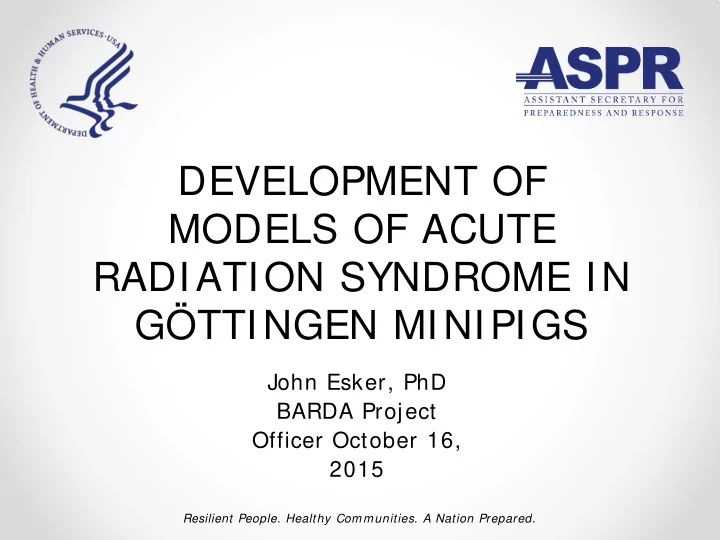

DEVELOPMENT OF MODELS OF ACUTE RADIATION SYNDROME IN GÖTTINGEN MINIPIGS John Esker, PhD BARDA Project Officer October 16, 2015 Resilient People. Healthy Communities. A Nation Prepared.
Minipig H-ARS Model Development Overview BARDA Minipig Collaborators Harmonization Efforts Natural History for h-ARS Multi-Institutional Lethality Curves Hematopoietic and Other Biomarkers MCM Efficacy Testing in the Minipig Model Conclusions 2
BARDA Minipig Collaborators BARDA Nonclinical Studies Network established IDIQ Contracts for Animal Model Development Three Minipig Task Orders were awarded in Apr-May 2012 Interagency Agreement signed with Armed Forces Radiological Research Institute (AFRRI) in Jan 2013 With BARDA, these institutions make up a Minipig Consortium to develop minipig ARS models. 3
Harmonization Efforts Documentation of all parameters was critical. BARDA required harmonization of key parameters (sex, age, size, housing, enrichment and veterinary care, euthanasia criteria). Harmonized parameters were used to establish the natural history and biomarkers for the minipig H-ARS model. H-ARS Biomarkers were assessed for consistency across institutions. Non-H-ARS markers distributed for breadth of coverage. 4
Natural History for H-ARS using Göttingen Minipigs Radiation dose-response curve (A) for the model is predictive with an LD50/ 45 comparable to canine but lower than murine and NHP ARS animal models. Kaplan Meier plot (B) shows similar time frame of mortality H-ARS as other murine, canine, and NHP models. Some deaths post 30 days support the 45 day duration of minipig studies. 5
Multi-Institutional Plot of Lethality Curves Parallel probit plots demonstrate general overall predictability and reproducibility of the model. A Dose Modification Factor (DMF) of about 1.1 observed between radiation sources and supportive care paradigms (CONOPs relevant prophylactic antibiotics and fluids). 6
Hematopoietic Markers Neutrophils and platelets are significantly impacted with dose-dependent nadir around day 15, similar to other H-ARS models. Similar data out to 45 days was reported across all institutions with incomplete recovery to Day 45. 7
Biomarker Targets High priority biomarkers were tested in multiple labs, to assess reproducibility. Institutions also performed a unique set of individual biomarkers, often based on lab expertise, to broaden coverage 8
ARS Clinical Markers Endotoxin –Low endotoxin levels observed, suggesting effectiveness of prophylactic antibiotics in this model. Body weight – Animals presented a steady weight gain for the duration of the studies. 9
ARS Clinical Markers Pathology – Moribund animals and survivors to terminal necropsy showed internal hemorrhage and injuries similar with other ARS models. Doses of 2.5-3 Gy were 100% lethal at 30 days, and showed significant lung collapse, effusion and cardiac injury. Evaluation of ARS sub-syndromes involving higher radiation exposures would require shielding of sensitive organ. 10
MCM Efficacy Testing in the Harmonized Minipig Model Testing of MCM Efficacy / Testing of the Model Blinded study performed at AFRRI under “GLP” Bilateral irradiation @ LD50, minimal supportive care Statistically powered to 0.7 for 30% change at α = 0.05 using an N= 24/ group 60 day study, longer term hematopoietic recovery data. 11
ARS Minipig Model Conclusions Gottingen minipig model demonstrates reproducible, predictable dose-dependent effects for H-ARS. Harmonized parameters provide a robust model suitable for qualification though the US FDA Program and evaluation of potential MCMs. Natural history and biomarkers are evaluated by survivors and non-survivors through Day 45. Partial body shielding for hematopoietic support and protecting specific organs is required for other ARS sub-syndromes involving radiation levels > 3 Gy. 12
Thank You 13
Recommend
More recommend